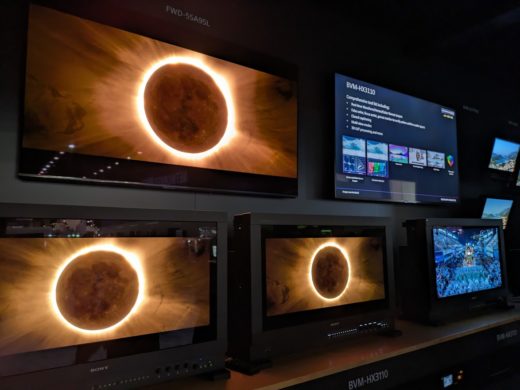
It’s an interesting day when ten or twelve thousand dollars seems like a modest price for a video display, but Flanders Scientific has just managed to make that situation into a headline. To be fair, this is in comparison to Sony’s extremely thoroughbred offerings in the rarefied world of high end reference displays for grading nine-figure blockbusters, a world where (we assume) people sip from goblets of champagne and rest their feet on the back of a cowering runner between tweaks of the trackball. At that level, the sticker price of a display is usually a rounding error, although the best reference displays have recently become sufficiently expensive that people have begun to notice.
It’s a rare news item in the world of monitors, most of which are, well, fine. It’s been a while since Atomos started being refreshingly upfront about the fact that, absent special situations like 360-degree video or ride films designed to genuinely fool the human eye, 8K is probably enough for anyone. More resolution isn’t really required. The bugbear has been precision and, particularly, contrast.
Genuine HDR display
Flanders’ new display, the XMP310, addresses these considerations. It’s a 30.5-inch UHD display based on Samsung’s quantum dot OLED technology, much like the company’s earlier 55-inch option which it intended as a client display. Taking nothing from Flanders, Samsung deserves full recognition here for having spent the time, effort, truckloads of cash that it presumably took to genuinely advance OLED technology. As a result, the XMP310 achieves 1,000 nits of brightness without resorting to the RGB plus white pixel structure which can affect the accuracy of bright colours on many HDR-capable consumer OLEDs.
The price is anticipated to hover around the eleven or twelve thousand dollar mark, but there is another reason to consider it something of a deal: built-in calibration. In itself that’s nothing new, given Eizo and others have been providing it to desktop displays for workstation for a long time. What’s new is that Flanders suggests its process is good enough to qualify it for finishing work for the big distributors, even using inexpensive probes such as the X-Rite i1Display Pro, which it showed on the booth.
That matters, given that a high-end probe can be a five figure device in itself. Many people rent them – the company suggests recalibration once every six to twelve months, depending on use. Calibration software can represent another multi-thousand investment, and specialist people to set things up also tend to be costly. The XMP310, then, is not only well-priced as a device, but if everything Flanders says is true it can also save on care and feeding.
Better probes are faster because they’re less noisy; inexpensive probes struggle to read low light level test patches and need to stare at them for a while to average out the noise. Assuming these claims are accurate, Flanders’ work here does go some way to explaining the longstanding question as to why lower-end probes couldn’t just read for longer and average out the noise. There are limits to doing that, but it seems that in principle they could. It’s just that nobody ever did. Still, to make all this work, Flanders talks about having done a deal with X-Rite to access low-level facilities that aren’t usually available via the probe’s USB interface, calibrating every probe to make it all work.
Sweet – and Flanders isn’t the only company offering a display around that size using the Samsung panel. SmallHD has been working on a somewhat parallel project around the same part. It’ll have the company’s page-based operating system and a few other differences (it’s not clear if SmallHD’s product will offer the same calibration facilities) but it seems there’s general agreement that the market is very ready for a less-expensive route to high end HDR.
A challenger
Sony has, inevitably, a challenger. The extremely lovely, extremely expensive BVM-X300 set such a standard that enthusiastic users stockpiled them when they were discontinued, a huge vote of confidence for a $30,000 display with, reputedly, a rather alarming tendency to burn in. Sony replaced the X300 with the BVM-HX310, a dual-layer LCD model capable of similar things at a similar price, but without the reliance on Sony’s abandoned (and much lamented) OLED manufacturing initiative. The Flanders release might make the similarly-specified BVM-HX310 look expensive – but Sony came to NAB 2024 with a new model, the BVM-HX3110, which increases peak brightness to 4,000 nits.
This is a number which reminds us of Dolby’s gigantic and similarly-specified Pulsar display. It’s this display which represented many people’s first exposure to true HDR, often showing beautiful footage of a polished metal aircraft flying into a sunset, with bright reflections running across its surface. The thing is, Pulsar was wonderful for demonstrations, but it was often felt that 4,000 nits is too much for everyday viewing. Some HDR distribution formats are specified up to that level, though, so we’re left trusting colorists to exercise restraint.
Yes, light.
Still, for anyone who actually does need to finish stuff for Netflix, there are new options, and some of them are considerably less expensive than before. For the rest of us, it’d be great to see other platforms, particularly online, make it easier to distribute HDR material – some of them will do it, but technical approaches vary. For anyone interested in an even more affordable solution, the pioneers of HDR for the masses were – here’s that name again – Atomos. We’ll talk to them in due course, but one of the big displays in the lobby of the Las Vegas Convention Center tells us that the company is now offering… lights? Well, okay. Watch this space.
